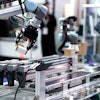
The Coronavirus disease (COVID-19) has upended the way we get work done, and much has been made of the sudden relocation of a great many desk jobs to hastily-arranged home offices. The needs of frontline workers are unique and massively underserved, however, once we consider that 4 out of every 5 employees don’t sit at a desk to do their jobs. Their desk-bound counterparts have productivity tools running on a computer that’s generally in front of them at all times. But, the deskless 80% — truly an enormous majority of the global workforce — are overdue to benefit from software applications that advance workplace connectivity, productivity and professional growth.
Current workforce tech falls short for frontline workers
One of the most obvious examples of problematic workplace tech is the common practice of group email as a default internal broadcast vehicle. The larger the company, the more likely their deskless/frontline employees are not assigned or expected to monitor corporate email accounts for various practical, legal and financial reasons.
Deskless employees tend to be less experienced, have less formal education and face greater obstacles to upward mobility. But, if the past 12 months of social isolation have taught us anything, it’s that a motivated individual at any stage in their career can access professional development/upskilling opportunities wherever there’s an internet connection. Considering the ubiquity of affordable smartphones and near-infinite potential for the manufacture of portable and even wearable hardware, why are we spending so little on applications that stand to benefit such a large majority of our workforce?
We cannot afford to ignore the tech needs of the deskless 80%
Businesses spend approximately $300 billion on software each year, but until recently, only committed a tiny portion of that to deskless technology. This has begun to change in the industries that employ the most frontline workers (hospitality, retail, healthcare, education, construction, and manufacturing are near the top of that list). Investment in deskless productivity ultimately pays for itself and then some -- there are bottom-line and productivity gains, but that’s not where the story ends.
Better connectivity, productivity, and professional growth awaits
The COVID-19 pandemic has ushered in a rapid evolution of technology that creates new advantages for deskless workers. Automation, training and gamification modules have already created promising case studies for replicable success.
- Recruitment/onboarding Frequent turnover and low long-term retention rates mean lots of time and money spent on hiring and onboarding frontline workers. Now, imagine each new employee can initiate an automated onboarding process on their phone. To begin, they need only enter their mobile number. While the subsequent automation saves on redundant human resource hours, the employer/employee relationship can begin with a push notification setup that far exceeds what was possible through corporate email infrastructure.
- Internal communication Push notifications ensure every employee is equally able to consume relevant information from their employer. Now, imagine each employee also has a tool for communicating effectively with their supervisors and deskless colleagues. Increased employee autonomy pairs with new ways for supervisors to share positive and constructive feedback in real-time.
- Training/safety Many manufacturers have recently implemented a portable software environment that assigns each machine a QR code. Now, imagine an employee can use their phone to instantly launch an instructional video on how to use it. Similarly, safety training migrates from the domain of intimidating paper manuals stored on shelves to machine- or floor-specific information available precisely at the time or place it’s needed.
- Performance-based gamification/rewards Deskless jobs often involve mundane or repetitive tasks that can be made more enjoyable and rewarding through “gamification,” which offers a motivated employee fun and quantifiable ways to assess and improve their own on-the-job performance. Now, imagine an employee can receive points for completing tasks. Enough points and you unlock a badge, enough badges and you reach a new “level.” Perhaps there’s even a leaderboard, encouraging healthy competition and bragging rights among colleagues. Prime candidates for internal promotion are easy to identify and overall morale improves dramatically.
- Professional development/upskilling When a motivated employee receives tangible rewards in this manner, they become more aware of their strengths and their ability to improve on-the-job performance over time. Now, imagine that employee gains access to portable professional development modules custom-designed to facilitate upward mobility in their specific career track/industry.
The future of workforce tech will usher in a new era of growth and opportunity for the deskless. Frontline workers will gain invaluable digital skills. They will get better at their jobs and feel happier in their workplace. Their employers will enjoy increased productivity. The benefits can only multiply from there. In fact, data shows this shift is already underway. We may not know all that awaits us on the horizon, but we can be sure that on-the-go workforce tech will inevitably aid our post-COVID path ahead.




















